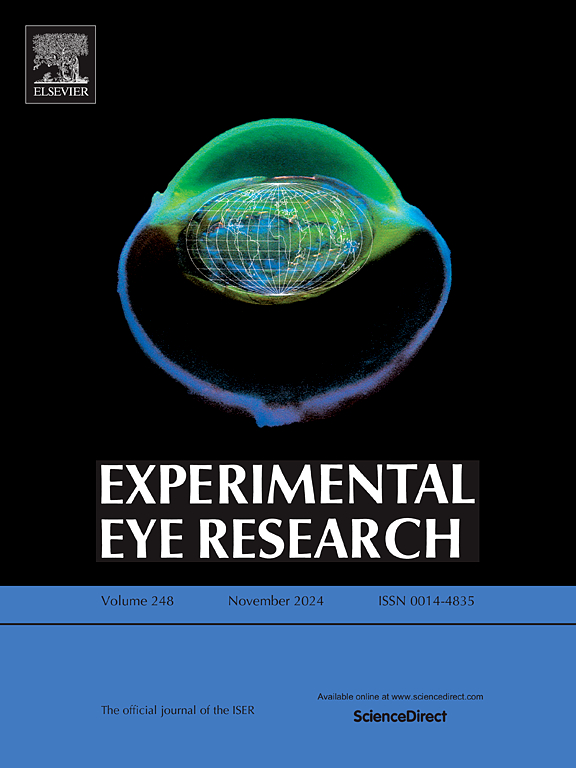控制麻醉小鼠眼压的升高
IF 3
2区 医学
Q1 OPHTHALMOLOGY
引用次数: 0
摘要
我们的目的是制定一种延长小鼠麻醉时间的方案,并评估眼压控制性升高(CEI)4小时对视神经轴突损伤的影响。在CEI期间,C57BL/6雄性小鼠(3-5个月大)用1.5%异氟醚加100%氧气麻醉4小时,然后放在温暖的平台上,主动排出呼出气体和麻醉剂。在 CEI 开始和结束时,皮下注射含 5%葡萄糖的乳酸环素(0.5 毫升)。在 4 小时的 CEI 期间全程监测生理参数(血氧饱和度 = O2、心率 = HR、收缩压 = SBP 和体温)。用连接到平衡盐溶液储液器的聚氨酯管对一只眼睛进行插管,并将眼压分别升至 20 毫米汞柱(18 只)、30 毫米汞柱(13 只)、50 毫米汞柱(14 只)和 60 毫米汞柱(16 只)。另一组 22 只雌性小鼠暴露于 60 mmHg 的 CEI。CEI 14 天后,由蒙面观察员评估视神经的轴突损伤情况,并按从 1(正常)到 5(>50% 的轴突退化)的等级进行评分。CEI 视神经损伤与对侧视神经(84 例)和正常视神经(18 例)的损伤进行比较,采用单因素方差分析,然后进行 Kruskal-Wallis 检验进行多重比较。通过线性回归分析评估了视神经损伤、生理参数和眼压之间的关系。在整个 CEI 期间,生理参数保持稳定(氧气 = 95 ± 9%;心率 = 450 ± 39;血压 = 102 ± 15 mmHg;体温 = 38 ± 0.7°C),组间无统计学差异(所有比较的 P > 0.5)。新生视神经(1.01 ± 0.02)的平均视神经损伤等级(±SD)与同侧/对侧视神经(1.03 ± 0.07,P>0.99)或与 20 mmHg(1.04 ± 0.08,P>0.99)或 30 mmHg(1.05 ± 0.06,P=0.6)的 CEI 没有显著差异。然而,暴露于 50 mmHg(2.09 ± 1.43,P=0.0005)和 60 mmHg(雄性:2.86 ± 1.30,P=0.0005)CEI 的动物,其血压和血糖值均低于雄性动物。本文章由计算机程序翻译,如有差异,请以英文原文为准。
Controlled elevation of intraocular pressure in anesthetized mice
Our purpose was to develop a protocol for prolonged anesthesia in mice and evaluate optic nerve axon injury in response to 4 h of controlled elevation of intraocular pressure (CEI). During CEI, C57BL/6 male mice (3–5 months old) were anesthetized with 1.5% isoflurane with 100% oxygen for 4 h and placed on a warm platform, with expired gas and anesthetic actively evacuated. Lactated ringers (0.5 ml) with 5% dextrose was administered subcutaneously at the start and end of CEI. Physiological parameters (oxygen saturation = O2, heart rate = HR, systolic blood pressure = SBP, and temperature) were monitored throughout the 4-h CEI. One eye was cannulated with polyurethane tubing connected to a balanced salt solution reservoir and IOP elevated to 20 (N = 18), 30 (N = 13), 50 (N = 14), and 60 mmHg (N = 16). An additional group of 22 female mice was exposed to CEI of 60 mmHg. Fourteen days after CEI, optic nerves were assessed for axonal injury by masked observers that assigned a grade on a scale from 1 (normal) to 5 (>50% of axons degenerating). CEI optic nerve injury was compared to injury assessed in contralateral optic nerves (N = 84) and naïve optic nerves (N = 18) using a one-way ANOVA followed by Kruskal-Wallis test for multiple comparisons. The relationship between optic nerve injury, physiological parameters, and IOP were assessed by linear regression analyses. Physiologic parameters remained stable throughout CEI (O2 = 95 ± 9%; HR = 450 ± 39; SBP = 102 ± 15 mmHg, and temperature = 38 ± 0.7 °C) and were not statistically different between groups (all comparisons had P > 0.5). Mean optic nerve injury grades (±SD) for naïve optic nerves (1.01 ± 0.02) were not significantly different from fellow/contralateral optic nerves (1.03 ± 0.07, P > 0.99), or from CEI of 20 mmHg (1.04 ± 0.08, P > 0.99) or 30 mmHg (1.05 ± 0.06, P = 0.6). However, animals exposed to CEI of 50 mmHg (2.09 ± 1.43, P = 0.0005) and 60 mmHg (male: 2.86 ± 1.30, P < 0.0001, female: 1.63 ± 1.00, P = 0.0006) developed significant optic nerve injury relative to their fellow/contralateral optic nerves. Axonal injury grades following a CEI of 60 mmHg were not significantly different between male and female mice (P = 0.19). Optic nerve injury positively correlated (P < 0.0001) with IOP and not with physiological parameters, indicating that the optic nerve injury is IOP-related. In conclusion, prolonged anesthesia in mice requires careful attention to animal physiology. With this, a 4-h exposure to elevated IOP can produce significant optic nerve injury with IOPs equal to or greater than 50 mmHg. We provide detailed descriptions of methods and materials for producing prolonged elevations of IOP in mice while maintaining and monitoring their physiology, as well as a unique, cost-effective transducer system for monitoring pressure delivery.
求助全文
通过发布文献求助,成功后即可免费获取论文全文。
去求助
来源期刊

Experimental eye research
医学-眼科学
CiteScore
6.80
自引率
5.90%
发文量
323
审稿时长
66 days
期刊介绍:
The primary goal of Experimental Eye Research is to publish original research papers on all aspects of experimental biology of the eye and ocular tissues that seek to define the mechanisms of normal function and/or disease. Studies of ocular tissues that encompass the disciplines of cell biology, developmental biology, genetics, molecular biology, physiology, biochemistry, biophysics, immunology or microbiology are most welcomed. Manuscripts that are purely clinical or in a surgical area of ophthalmology are not appropriate for submission to Experimental Eye Research and if received will be returned without review.
 求助内容:
求助内容: 应助结果提醒方式:
应助结果提醒方式:


